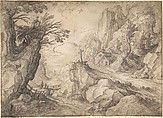A Mountainous River Landscape with a Hermit and a Chapel
Matthijs Bril the Younger Netherlandish
Not on view
At the center of this mountainous landscape two travelers are about to cross a bridge. Their appearance is dwarfed by the imposing rock formations flanking the valley. On the top of the cliff to the left, nearly hidden from view, a hermit is reposing in his solitary retreat. A bit further down the hill stands a lonesome goat, cautiously observing the travelers, who are possibly heading to the little chapel, seen to in the right background.
The drawing was previously attributed to the prolific landscapist Paul Bril (1553/54–1626).[1] Currently, however, it is considered a work by his brother, Matthijs Bril.[2] Typical of Matthijs’s drawings are the broad and vigorously applied pen and ink lines, and strong chiaroscuro effects obtained through dense parallel hatching. As opposed to his brother, he did not use washes for modulation. The artist had a predilection for imposing rock formations to add a more dramatic dimension to his compositions. Inspiration for this scenery may have derived from the artist’s observations when travelling through the Alps on his way to Italy, around 1570.
The composition has a strikingly elaborate underdrawing in black chalk, parts of which have been effaced. Traces are still visible for example around the rock, situated just above the little chapel to the right. Similarly, a bridge can be discerned, spanning between the cliff of the hermit’s den and the rock, crowned with a cross. These are interesting pentimenti, and telling testimony of the creative process of the artist.
[1] R. Day, An Exhibition of European Drawings and Manuscripts, London: Richard Day, 1990, cat. no. 17.
[2] Dr. Louisa Wood Ruby, author of the monograph on Paul Bril, confirmed the attribution to Matthijs. Cf. Museum files.
Due to rights restrictions, this image cannot be enlarged, viewed at full screen, or downloaded.



